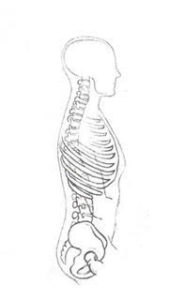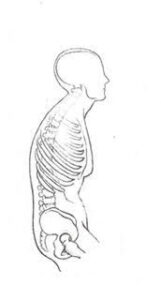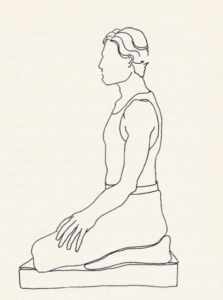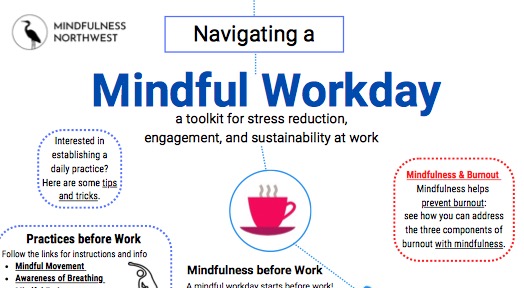Posture is the structural basis of our upright position. And posture supports our upright position in meditation. But it is tricky. We are guided to be upright, but relaxed – not too tight, and not too loose. But what does this all mean? If I’m “relaxed,” I feel my shoulders slump forward and my whole body submit to gravity – that is not the position I want. But, if I strive too much, I feel fixed and rigid. Is there a balance?
Yes, a resounding yes! I’ve been a student of posture since I struggled with significant back injuries years ago. First, as always, let’s start with definitions. Posture is alignment of the bones of our spine, the vertebrae. Correct posture is when these bones are aligned in their intended manner – allowing curves in the region of the low back, the thorax or chest, and the neck (see Figure 1, below). The final five vertebrae of our spine are fused to form the sacrum, at the back of the pelvis.
Figure 1
Figure 2
Contemporary life conspires to pull our vertebrae out of alignment. A common way (but not the only way!) stems from our hours in front of a screen, and/or use of arms to lift things. This is a “flexed” posture, or “C-shaped” posture (See Figure 2, above). Is this you? You are not alone. Can you see the loss of the normal lumbar curve, exaggerated thoracic curve and cervical (neck) curve? Many try to correct this with the advice “bring your shoulders back and down” but this more often than not creates no change in the upper, rounded, back, and forward-positioned shoulders, but leads to an exaggerated change through the low back – an “S-shaped” posture (see Figure 3, below), a posture that is often uncomfortable.
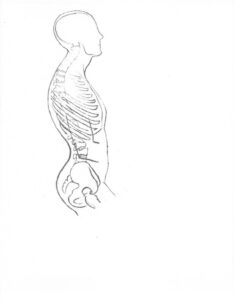
What to do? Learn about your own body! Lie on your back on the floor, with your knees bent, and feet flat on the floor. Use a pillow or rolled towel to support your head if that is most comfortable. Try to completely allow your weight to be held by the floor. Release the muscles of the low back. Avoid any sense of pushing any part of your spine or body onto the floor. Then, feel where your body contacts the mat. You’ll likely feel it heavy at the back of the pelvis (the sacrum), less heavy at the low back (reflecting the lumbar curve), some contact between your shoulder blades (reflecting the thoracic curve) and no contact at the neck (reflecting the curve of the cervical spine). Then, alternately gently press your low back to the mat and lift your low back off the mat – in a pelvic rocking motion, 6 or 8 times. After this motion, feel where your low back settles.
Come to sitting, and do the same movements, seeking the same balance of the spine, only now upright. These movements can help you feel the most balanced contour of your low back.
But what about those rounded shoulders? Sitting upright, with awareness of your low back, slowly and gradually pull your shoulder blades together. Feel them come together behind you. Avoid a rapid, forced movement. Feel how this motion supports a lift in your sternum. Feel the activation of the muscles of your upper back that live between the shoulder blades. This lift of your chest should create a slightly straighter upper back, not just an increase in the curve of your lumbar spine. This takes some practice!
When I settle into a seated position for a formal meditation practice, I do a scan of my spine. First, I feel my seat bones (those prominent bones that we sit on – the base of the pelvis) on the bench or cushion and try to allow my weight to be fully held by those seat bones – this often results in a gentle, positive release of over-tight leg and shoulder muscles. Then, I do very small front-to-back pelvic rocking motions. This supports balance over the seat bones. I do a slow scan of my upper back and torso noting if my shoulders are tending forward. If so, I gently bring my shoulder blades together, keeping the position of my pelvis unchanged. I feel an activation of the upper back muscles that allows my shoulders to soften, and my head and neck to feel balanced over my shoulders. Over the course of my practice, I may need to repeat this alignment check when I feel my upper body sink. If I’m too abrupt with these postural adjustments I can easily overdo it and feel tight and tense. In the end, I seek a position of supported balance. This position, for me, enhances awareness of the sensations of breathing and creates a sense of openness.
One other note about posture and meditation. Do you sit on a cushion? If so, be sure that your pelvis is lifted. For most of us, tight hamstring muscles (those strong muscles of the back of the thigh) make it difficult for us to sit upright without a rounded back if we sit directly on the floor. By sitting with your pelvis lifted and supported several inches above the floor, some of the stretch and strain is taken off of the hamstrings, which allows your back to assume its normal curves. Explore different cushions to find the position of your pelvis that allows you to adopt good posture while sitting (see Figure 4, below.)
Figure 4
Why care about posture? It is the healthiest position of the spine. And while it may take some time to develop the needed awareness, and muscular control and strength to support this position of the spine in meditation, with time, you’ll be able to hold the position with ease. Ease won’t come from just relaxing, ease will come from settling into this balanced position of the spine and torso. And, good posture supports a positive sense of self, contributing to focus and presence during meditation.

